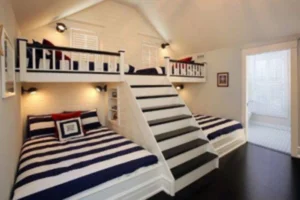
1. Introduction: More Than Just Cute Furniture
When designing a child’s room, it’s tempting to focus on fun colors and adorable themes—but there’s more to kids furniture designs than just being cute. Children grow fast, and so do their needs. That’s why it’s important to choose furniture that’s thoughtfully crafted for their size, safety, and developing imagination.
A. Why kids need furniture tailored to their size, safety, and imagination
Imagine a toddler trying to climb onto an adult-sized chair or struggling to open a tall wardrobe. Furniture designed specifically for kids encourages independence and makes daily tasks easier. Rounded corners, anti-tip shelves, and non-toxic finishes ensure safety is never compromised. And with creative kids furniture designs—like rocket bookshelves or cozy reading tents—furniture becomes part of their play and learning experience.
B. How well-designed pieces can boost learning, creativity, and comfort
The right environment plays a huge role in a child’s development. A comfy reading nook can nurture a love for books. An organized study desk can make homework less stressful. And a bed that doubles as a play fort? That’s an instant joy-booster!
C. Today’s trend: blending aesthetics with adaptability in children’s rooms
Gone are the days of buying new furniture every few years. Today’s kids furniture designs focus on growth-friendly, multi-functional pieces that evolve with children. Whether you prefer a colorful jungle theme or a minimalist look, the goal is clear: furniture that’s stylish, practical, and built to last.
2. Designing with Growth in Mind
Children outgrow clothes, toys—and yes, even furniture—faster than we expect. That’s why smart parents and designers today are investing in pieces that grow with the child, rather than ones that need to be replaced every couple of years. Designing with growth in mind means creating a space that can evolve from nursery days to teenage years with ease, style, and practicality.
A. Adjustable desks, extendable beds, and modular storage
Extendable beds expand as your child grows, while adjustable desks and modular shelves evolve with changing needs. These kids furniture designs save money and eliminate the need for frequent upgrades. Add modular storage that can be rearranged or expanded as their interests change—one year it’s storybooks and plush toys, the next it’s art supplies and gadgets.
B. Furniture that evolves from toddler to teen
A well-designed kids’ room isn’t just cute—it’s clever. Think of a crib that converts into a toddler bed, or a changing table that turns into a study desk. These transitional pieces offer continuity, so your child’s room doesn’t need a complete overhaul every few years. With flexible features and timeless designs, you can support their growth without constantly updating the furniture.
C. Long-term value vs. age-specific purchases
Yes, that bunny-shaped chair is adorable—but will your child still want it at age 10? Choosing neutral tones, classic shapes, and scalable features ensures your furniture stays relevant as your child matures. While age-specific designs might look charming now, they often have a short shelf life. Investing in quality, adaptable furniture means you get more value for money and fewer replacement headaches in the long run.
3. Safety First: What Parents Should Know
When it comes to children’s furniture, safety isn’t just a feature—it’s a necessity. Kids explore their world by climbing, crawling, jumping, and occasionally tumbling. That’s why every design decision should prioritize their well-being, from the choice of materials to the overall room layout.

A. Rounded corners, non-toxic finishes, and anti-tip features
Children are constantly on the move, and sharp edges are a common cause of minor injuries. Furniture with rounded corners helps reduce the risk of bumps and bruises. Additionally, choose non-toxic paints and finishes that are free from lead and harmful chemicals—because little hands often go straight to little mouths. For tall items like bookshelves or wardrobes, anti-tip hardware is essential to prevent accidents.
B. Importance of certified materials and sturdy construction
Durability isn’t just about longevity—it’s about safety too. Look for kid-friendly certifications (like BIS, GREENGUARD, or EN safety standards) that ensure furniture meets strict guidelines for both structure and materials. Well-built furniture with stable frames and solid joinery can withstand daily wear and tear—whether that’s a toddler climbing it or a pre-teen slamming drawers shut.
C. Smart layouts to avoid clutter and hazards
Even the safest furniture can become risky in a cluttered or cramped space. Plan your child’s room layout to allow ample walking space, especially near beds and play areas. Low-height storage encourages kids to clean up after themselves and keeps toys off the floor—reducing tripping hazards. A well-organized room is not only safer but also promotes calm, focus, and creativity.
4. Space-Saving & Multi-functional Solutions
In today’s compact homes, especially when children share rooms or space is limited, furniture must do more than just look good. It needs to be smart, flexible, and multi-functional—helping parents maximize utility without compromising on comfort or style.
A. Bunk beds with study areas, beds with storage drawers
Bunk beds are a classic space-saver—but modern designs have taken them a step further. Today, you’ll find bunk beds with integrated desks, bookshelves, or wardrobes, turning one piece into a complete solution for sleep, study, and storage. Similarly, platform beds with pull-out drawers or hidden compartments underneath are perfect for storing toys, linens, and seasonal clothes—keeping the room clutter-free and organized.
B. Foldable tables, stackable chairs, and convertible cots
Flexibility is key in kids’ rooms. Foldable tables can be tucked away when not in use, creating more play area. Stackable chairs are easy to store and pull out only when needed—great for craft sessions, reading corners, or group play. For infants and toddlers, convertible cots that transform into toddler beds or even seating offer long-term value without requiring a complete room makeover as they grow.
C. Ideas for small bedrooms and shared sibling spaces
In homes where siblings share a room, smart zoning becomes essential. Use room dividers, color coding, or personal shelving to give each child a sense of ownership. Loft beds with play zones or wardrobes below free up floor space while still feeling fun and personalized. Wall-mounted foldable desks, hanging storage, and ceiling-high shelving can further optimize vertical space without overwhelming the room.
5. Fun Meets Function: Designs Kids Love
Kids’ furniture isn’t just about utility—it’s about sparking imagination and creating a space they truly enjoy spending time in. When functionality is wrapped in fun, children are more likely to use their furniture independently, develop better routines, and feel a stronger connection to their rooms.
A. Theme-based beds (cars, castles, treehouses)
Nothing excites a child more than a bed that doubles as a fantasy world. Whether it’s a race car bed for a budding driver, a princess castle for a fairytale dreamer, or a treehouse bunk for little adventurers, themed beds add play value to everyday routines. These designs turn bedtime into an experience, not just a necessity—making it easier for parents to encourage good sleep habits.
B. Colorful wardrobes, chalkboard headboards, and pegboards
Beyond beds, playful functionality extends to storage and decor. Vibrant wardrobes in cheerful hues, headboards with chalkboard paint, or pegboard walls for hanging art and accessories all give kids tools to express their personalities. These fun elements make organization enjoyable and help develop creative habits, whether it’s drawing, decorating, or arranging toys.
C. Involving kids in picking the style or motif
One of the best ways to make a child love their space is to involve them in the decision-making. Let them choose the theme, favorite colors, or even certain furniture pieces. This sense of ownership builds confidence and ensures the design truly reflects their world. Plus, when children feel heard, they tend to respect and care for their space more.
6. Storage That Encourages Tidiness
A. Toy organizers, open shelves, under-bed bins
Kids thrive on accessibility. Toy organizers with labeled bins, low-height open shelves for books, and under-bed pull-out drawers allow children to easily see and reach their belongings. This encourages self-reliance—whether it’s tidying up after playtime or grabbing a bedtime story on their own.
B. Personalized storage: name tags, color-coded zones
A clever way to make cleanup appealing is through personalized storage. Use name tags on drawers or assign specific colors to shelves for different categories—books, toys, art supplies. These simple visual cues help kids learn where things belong, while also creating a sense of ownership and pride in keeping things neat.
C. Teaching kids responsibility through furniture design
Furniture can play a big role in developing early responsibility. When storage is at the child’s eye level, easy to use, and engaging, it becomes a tool for learning rather than just a place to stash things. Over time, this helps kids build consistency, accountability, and a stronger connection to their environment.
7. Eco-Friendly Kids Furniture
A. Sustainable wood, bamboo, recycled plastics
Many parents now prefer furniture made from responsibly sourced wood, such as FSC-certified timber, or fast-growing bamboo, which is naturally antibacterial and highly renewable. Recycled plastics are also becoming popular for storage units and accessories, offering durability without environmental harm.
B. Low-VOC paints and water-based polishes
Children are especially sensitive to indoor air quality. That’s why low-VOC (Volatile Organic Compounds) paints and water-based finishes are a must. These safer alternatives reduce exposure to harmful chemicals, making the furniture both kid-safe and planet-friendly. Look for certifications like GreenGuard or EN71 standards when shopping.
C. Brands and practices to look for
More brands are adopting eco-conscious practices. From using biodegradable packaging to offering recyclable furniture, ethical manufacturers are setting new standards. When selecting kids’ furniture, choose brands that transparently share their sourcing, manufacturing, and sustainability efforts. Bonus points if they offer durable designs that can be reused or passed down, reducing waste over time.
8. Custom-Made vs Ready-Made Furniture
When furnishing a child’s room, one of the biggest decisions parents face is choosing between custom-made and ready-made furniture. Each option comes with its own set of benefits, limitations, and ideal use cases.
A. Benefits of bespoke furniture for unique room dimensions or themes
Custom-made furniture allows for complete personalization — perfect for oddly shaped rooms, specific themes (like space adventures or jungle safaris), or tailored storage needs. Whether it’s a bunk bed that fits into a sloped ceiling or a study table with built-in art storage, custom pieces make the most of available space and imagination.
B. Cost and time considerations
Going custom often means a higher price tag and longer delivery timeline, as every piece is built to order. However, the result is often better long-term value, especially when designed to grow with your child. In contrast, ready-made furniture is usually budget-friendly, immediately available, and ideal for quick setups or temporary use.
C. When to go custom and when to go modular
Choose custom furniture when you’re setting up a permanent home, dealing with space constraints, or aiming for a one-of-a-kind room. Go with modular or ready-made pieces if you’re renting, frequently relocating, or need a quick solution for a fast-growing child. Modular systems also offer the flexibility to rearrange and expand as your child’s needs change.
9. Conclusion: Building a Room That Grows With Them
A. Furniture that adapt,s delights, and supports your child’s journey
The best kids furniture designs adapt to changing needs, spark creativity, and bring joy to everyday routines—from reading to resting to imaginative play. It’s about creating a nurturing environment that grows with them—supporting their learning, play, and rest, all while keeping them safe and inspired. The best kids’ furniture adapts to changing needs, brings joy to everyday routines, and sparks creativity at every stage.
B. Encouragement to invest in thoughtful, long-term design
Rather than chasing short-term trends or buying age-specific furniture that’s outgrown in a year, investing in versatile, ergonomic, and quality pieces can offer better value and comfort. From extendable beds to adjustable desks and clever storage, every design choice can shape better habits and happier spaces.
C. Call to action: Explore child-focused furniture that blends safety and style
Ready to design a space your child will love to live, learn, and grow in? Explore child-focused furniture that balances style with safety, durability with delight, and function with fun. Because when furniture grows with your child, so does their confidence, comfort, and creativity.




